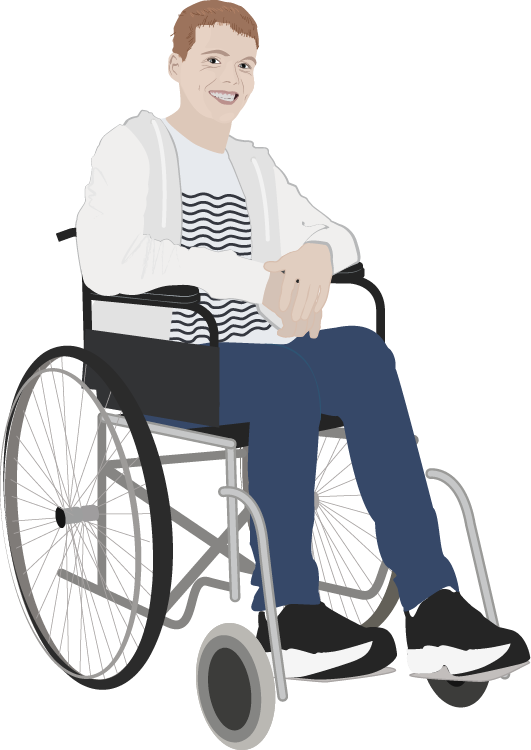At FEI Systems, we’ve been creating innovative technology solutions that change the way health and human services are delivered for more than two decades, but it’s really not about the technology. For us, it’s about supporting the meaningful work of the agencies and organizations we serve. And ultimately, it’s about improving outcomes and quality of life for the people they serve.
The stories on this page represent thousands of individuals … and they are the reason we do what we do.
Analissa
Analissa spent the first month of her life in the neonatal intensive care unit (NICU). Born eight weeks premature, she only weighed two pounds at birth. Her stay in the NICU has been further complicated by respiratory distress syndrome, sepsis, and IV nutrition.
Once Analissa began oral feeding, her doctor believed it is time for her to go home. She needed continued, regular medical care, but she ccould finally leave the NICU.
Analissa’s mother and older brother were excited to be welcoming her home at last, but they are anxious about managing Ana’s unique medical needs alone.
Member Portal Advantages
Ana’s doctor designs a discharge plan that includes home oxygen support, nursing visits three times per week, and parental CPR training. Prior to leaving the hospital, Ana is assigned a case manager who will oversee the discharge and provide care coordination once Ana is home.
The final preparations include providing a login for a web-based member portal for Ana’s mother, so she could easily check-in with the case manager and providers. When Ana’s mom first logs in to the portal, she finds a digital welcome packet, complete with home readiness tips, car seat and bed use safety information, and a list of local family support services.
Ana’s mom can use the member portal to search for local providers with skills to meet Ana’s unique medical needs. She can also send/receive messages and video calls with Ana’s case manager from the portal.
Blue Compass Case Management for LTSS
Ana’s case manager also has a portal login to the Blue Compass system the state uses for case management for LTSS. Ana’s case manager can view all upcoming tasks and alerts pertaining to every client, including Ana, on her personal dashboard in the system.
Using the Blue Compass portal, Ana’s case manager authorizes and verifies that an oxygen delivery device and pulse oximeter are delivered and available in Ana’s home prior to discharge. The case manager also issues a referral for public health nursing and schedules home health visits for Ana by comparing the provider and family digital calendars.
The Blue Compass case management platform is designed to simplify the coordination of care for individuals receiving home and community-based services. This means Ana’s mom can finally bring her daughter home with the comfort of knowing there is a support team dedicated to providing the care Ana needs and managing her follow-ups.

Elijah
Elijah is a 15-year-old high school student with autism and cerebral palsy. He lives at home with his single, working mother and younger sister. Since he is wheelchair dependent and has limited use of his hands, his mom helps him with many of his daily tasks, including getting dressed, brushing his teeth, etc.
Elijah receives Medicaid benefits for long-term services and supports (LTSS) programs in his state. With the help of shadow support providers, he can attend school, but there are many times he is home alone while his mother is at work.
Prioritizing Home Care
As he gets older, Elijah tries to maintain his independence as much as he can. He does homework on an iPad, plays computer games with friends, and likes to snuggle with his cat, Koko. Despite these positives, he is still feeling isolated and hast started to show signs of moderate depression.
The realities of caring for Elijah alone are getting harder for his mom. Not only is his care more physically demanding for her, but she also has a limited support system and must regularly juggle his at home care with her full-time job.
Elijah’s shadow provider helps him get to and from school, but his mom worries about him being home alone on the afternoons he is not at tutoring. She takes off from work when school is closed, something her most recent employer cannot support, and she loses her job.
Blue Compass Long-Term Services and Supports
Elijah’s mother applies online for her state’s Intellectual and Developmental Disabilities Medicaid waiver. Within a few days, she gets access to a member portal where she receives messages from Elijah’s new case manager about upcoming screenings, assessments and his new plan of care. Elijah, his mom, and the case manager choose from a list of home-based care providers with experience unique to Elijah’s needs.
The Blue Compass long-term services and supports (LTSS) solution features a person-centered plan module that allows case managers and members real-time access to their plan of care. Using this portal, Elijah and his mother can create a profile that captures their vision of a good life, personal strengths, preferences, dislikes, things they would like to try, cultural considerations, and more—all of which factor into Elijah’s person-centered plan of care.
Personalized home-based care allows Elijah to maintain his independence and stay home with his mom, little sister and beloved cat. Elijah, his mom and his support team can coordinate physical and speech therapies, custom orthotics, seating and positioning devices, and more through the Blue Compass LTSS platform.

Chris
Chris is a service administrator who works for a regional case management center.
His long, often tedious, workdays are filled with paperwork and seemingly endless phone calls with licensed providers to try and resolve issues with Medicaid claims. As Medicaid enrollment expands in the state, he starts to feel more and more strain and frustration at work.
However, when his department implements Blue Compass, a case management solution that includes a module for claims and invoice management, Chris can go back to focusing on what he loves – helping people get the care they need when they need it.
Blue Compass Claims and Invoice Management
Before implementing Blue Compass, Chris struggled to resolve many issues with claims and regularly had to track down providers to resolve them. As an example, a local home care provider has been sending paper-based billing invoices to the department of health. Chris must reject several claims solely based on illegibility.
But, when the department implements the Blue Compass case management for long-term services and supports, there is a module that can directly address Chris’s needs. The billing and claims verification service support Electronic Data Interchange (EDI) standards to seamlessly send and receive claims data to Medicaid for verification.
For Chris, that means he can rely on Blue Compass to automatically aggregate claims from all state providers and send a single EDI document to Medicaid.
Keeping Focus on the Patient
With native support of HIPAA’s EDI transactions (including 270, 271, 837, 999, 276/277 and 835), the module can integrate with multiple payers and funding sources. This includes interfaces with state Medicaid systems to determine a person’s eligibility, including retroactive eligibility, ensuring comprehensive coordination between eligibility and service delivery.
The claim information includes:
• A description of the patient
• The patient’s condition for which treatment was provided
• The services provided
• The cost of treatment
The Blue Compass reimbursement and claims processing module streamlines and relieves a huge administrative burden of managing healthcare claims for Chris. And for him, the best part is, patients receive the care they need, when they need it, without any administrative roadblocks.

Imani
Imani serves as the director of an outpatient opioid treatment program in her community. Her staff administer mental and behavioral health services and medication-assisted treatment (MAT) programs, which includes prescription pain relievers used for drug addiction detoxification.
The city health department estimates that thousands of residents in the surrounding area are addicted to opioids, with her neighborhood at the epicenter of the crisis.
Imani is regularly challenged the varying needs of her growing clientele. The Blue Compass suite of solutions offers her valuable tools in the day-to-day running of the clinic, program management and State Opioid Response (SOR) grant reporting.
Protecting Data in Mobile World
The opioid epidemic has touched almost every corner of her community, and thus her clients come from all walks of life. Most are eager to regain their sobriety and understand the importance of consistent treatment in their recovery.
Successful treatment requires continued access to medications while traveling. For those receiving daily methadone (a prescription painkiller) maintenance, leaving town can prove cumbersome for clients as they must sign and fax paper authorization forms and methadone-related health records to other clinics.
With the Blue Compass consent management tool, Imani’s clients use an online consent management system to give the clinic advanced authorization to share methadone-related health information to other clinics and vice versa.
The Blue Compass consent management module is an open-source software application that allows participants to decide what health information they would like to share, and not share, with their primary and specialty providers. The web-based user interface is accessible on smart devices and desktops, supports data segmentation and is HIPPAA and 42 CFR Part 2 compliant.

Jennifer
Jennifer is a physician at a large, urban health system. She and hundreds of her peers provide lifesaving care to thousands of patients across almost every medical specialty each year.
Many of the patients seeking attention at her facility use Medicaid for primary insurance. While Jennifer and a small number of her colleagues work with Medicaid for claims, low reimbursement rates and cumbersome administrative processes keep most of her peers from enrolling as Medicaid providers.
Recently, her health system gained access to the Blue Compass provider management portal used by state Medicaid agencies, making it easier for Jennifer to log in to track her Medicaid enrollment status, to make maintenance updates to her provider file, and submit Medicaid claims for processing.
Streamlined Applications and Credentialling
Now, when Jennifer and her peers fill out new applications, or need to make updates to their provider record, including revalidation, they can quickly see what information is required for Medicaid and the system will not allow them to proceed until all documentation and information has been provided.
In fact, the automated system flags all provider risk levels and can fast track low-risk applications to get providers ready to see Medicaid patients sooner. Once enrolled, the single sign-on portal is used to continue to maintain the provider record, view claim status and verify eligibility for patients and review reports pertinent to the enrolled providers based on security roles.
Blue Compass Solutions
FEI Systems developed Blue Compass solutions with an enterprise approach to whole-person care, merging healthcare business processes, extensive IT capabilities, and industry best practices. Additionally, the Blue Compass case management solution for LTSS implemented in Washington, D.C. was the first LTSS platform in the nation certified by the Centers for Medicare and Medicaid Services (CMS).
FEI’s Blue Compass provider management module is designed to streamline enrollment, credentialling and oversight. It can be implemented as part of the Blue Compass LTSS case management platform, or integrated directly into a state’s existing IT ecosystem.
Additionally, the module serves as a database for practice and hospital administrators, allowing them to view and maintain provider information as well as claims, eligibility and remittance advice data. The automated system is also interoperable so information can be shared across other agency systems.

Justin
Justin is a community housing coordinator at Housing Alliance, a local non-profit organization that provides community support services to people in need.
Despite the long hours for minimal pay, nothing makes Justin happier than helping an individual or family in need find, and get settled in, their new home.
So, today, when Justin logs into the Housing Alliance portal, and two tasks appear on the home page alerting him to new at-risk clients in need of a housing transition, he takes a sip of his morning coffee and gets to work.
Person-Centered Approach
On a daily basis, Justin works with eligible people to find affordable housing, move-in support and supplies, and representative payee services. With so many clients and service providers to keep track of, Justin is grateful for the web-based portal his state employs for managing waiver population needs.
Today, Justin selects the new tasks and reviews the case notes to quickly get an overview of his new clients. One patient is an elderly man who fell at home and was admitted for in-patient rehabilitation. He now needs help transitioning into an assisted living program. His other new client is a recently unemployed single mother who is in recovery and applying for subsidized housing.
Justin returns to the home page, selects a button to send his new clients pre-configured intake questionnaires, and then returns to his task list. The web-based platform Housing Alliance employs for client management provides Justin a single view of all his clients, services and programs.
Blue Compass Case Management
The Blue Compass suite of solutions includes comprehensive case management modules for behavioral health and long-term services and supports, including home and community-based services. With interoperability as a key component for our platform, Blue Compass solutions streamline and enhance data sharing between local organizations and state and federal agencies.
Integrated, whole-person care includes access to affordable housing and community services. Blue Compass case management solutions make it easier to manage large caseloads and provide quality care. Working behind the scenes to consume data from hospitals, health and human services agencies, and local organizations, the Blue Compass platform lifts the massive administrative burdens that slow down intake, referrals, and client management.

Monica
Monica is the director of her state’s department of developmental disabilities, reporting directly to the state secretary for health and human services. Her department serves thousands of Medicaid participants – people of all ages with varying degrees of need.
Monica knows that most Medicaid participants will not speak up if they are not receiving the full extent of services granted via waiver programs. Often, they fear they will lose the benefits they so heavily rely on. She, therefore, has made it her personal mission to ensure department money and resources are distributed so all participants have what they need for care in their communities.
Executive Reporting Dashboard
As the agency director, Monica wants to know that services are provided in a timely manner and in compliance with federal regulations. She also wants to understand any inefficiencies and deficiencies in care, so adjustments can be made in short order.
With a few clicks of her mouse, Monica can customize her executive dashboard to view program data by region, member type, services provided, etc. These insights let her see if there are services lacking or resources allocated inappropriately in different areas of the state.
This dashboard – a part of the Blue Compass case management solution – also helps
Monica generate custom reports for the secretary of health and human services and the Centers for Medicare and Medicaid Services (CMS). To ensure reporting compliance and timeliness, Monica can set workflows within the case management platform to generate alerts for case managers to complete required reporting tasks before her deadlines.
Blue Compass Case Management for LTSS
The Blue Compass case management platform for LTSS employed by the department of developmental disabilities is used by everyone working for, and impacted by, the department. As director, Monica uses the executive dashboard for reporting and oversight. Department case managers use their portal logins to manage their caseloads from personalized dashboards, complete with client information, tasks, alerts, and case notes. Finally, program participants are given a member login to communicate with case managers and search for local providers and services.
The Blue Compass case management platform is configurable to adopt the unique workflows and business rules Monica’s department needs to be successful in the quality delivery of care and services. Upon implementation, the system provides a historical view of all previous member data. Agency administrators, like Monica, can easily view data and reports from across the state and further sort by gender of participant, location, date of report, provider, etc. These reporting tools help agencies understand trends and understand success of programs.

Patrice
Patrice is the chief information officer of the state department of mental health.
More state residents are seeking mental illness care than ever before, likely due to periodic lockdowns and social isolation during the COVID-19 pandemic. The state has also not been immune to the opioid crisis, and there has also been an increase in substance use disorder among residents.
Patrice has been tasked with developing the enterprise-wide strategic plan to improve the state’s technical infrastructure to meet the expanding need for health and human services in her state.
Configurable to Meet State Needs
Patrice is searching for modern health IT solutions that are interoperable and scalable to meet the growing demand for statewide behavioral health and long-term services and supports programs. She wants a commercial solution that can be configured to meet the unique needs of her state’s reporting requirements and its members’ care.
While she understands web-based solutions are the way of the future, security remains a top priority for Patrice, as she is deeply concerned about protecting member data.
Lastly, like any state administrator, Patrice must also consider price and efficiency. She wants to implement a solution that can accomplish all her department’s needs, while also being able to integrate with other state systems, as required.
Blue Compass Solutions
Ultimately, Patrice selects the Blue Compass suite of solutions for cross-agency care coordination for the most vulnerable populations of her state.
FEI Systems developed Blue Compass solutions with an enterprise approach to whole-person care, merging healthcare business processes, extensive IT capabilities, and industry best practices. Additionally, the Blue Compass case management solution for LTSS implemented in Washington, D.C. is the only LTSS platform in the nation certified by the Centers for Medicare and Medicaid Services (CMS). This allows D.C. to quality for the 90/10 federal match for design, development and implementation of health IT solutions.
As an organization, FEI maintains Capability Maturity Model Index (CMMI) Level 3, International Organization for Standardization (ISO) 20000 and 27001, and HITRUST Certifiable Security Framework (CSF) certifications. Patrice knows that a Blue Compass implementation will be supported by FEI’s enterprise standards, processes, and protocols.
The Blue Compass solutions are aligned to the Medicaid Information Technology Architecture (MITA), which places a primary focus on interoperability, extensibility, security, and compliance with standards such as HIPAA and Health Level 7. Blue Compass modules integrate with external systems to reduce costs, promote data quality and improve programmatic health outcomes.

Sarah
Sarah is a 34-year-old single mother of two struggling through her recovery from substance use disorder (SUD). The city health department estimates that thousands of residents in her community are addicted to opioids, with her neighborhood at the epicenter of the crisis.
Childcare responsibilities have forced Sarah to take extra time off work, and her employer cannot support her needed flexibility. Unfortunately, after a year of sobriety, when Sarah unexpectedly loses her job, she relapses.
For the sake of her children and ailing grandfather, Sarah seeks help at a newly built outpatient rehabilitation program in her community.
Staying the Course
Sarah is enrolled in SNAP and other Medicaid programs, so she goes online to see if she is eligible for additional support for SUD. The state she lives in manages State Opioid Response (SOR) grants and has established several outpatient rehabilitation programs.
After Sarah fills out an easy-to-use, web-based screener and behavioral health assessment, she connects with a new case manager who will help coordinate her recovery efforts. Sarah is eligible for the new outpatient, medication-assisted treatment (MAT) program, which adds prescription pain relievers used for drug addiction detoxification to counseling and behavioral therapies.
Blue Compass Behavioral Health Case Management
Using the Blue Compass case management solution employed by the state, Sarah’s case manager quickly sends a referral to a contracted treatment provider to begin community-based mental health services. Sarah is immediately provided a series of authorized recovery support services, including mutual aid groups.
As her treatment progresses, the Blue Compass platform sends alerts to Sarah’s medical providers to e-prescribe Narcan and Methadone before her refills run out. Electronic prescriptions, pharmacy details, orders and lab results are all tied together in the system’s treatment planning functionality.
Because time sensitivity is critical in SUD treatment, prevention, and recovery, FEI Systems developed the Blue Compass behavioral health case management solution to bring together a team and a wealth of resources to support member journeys toward long-term sobriety.

Nolan
Nolan recently graduated from college with a degree in social work. He has moved to a rural area in his state and is eager to make a positive difference for his new community as a case manager for his county’s aging and disabilities agency.
Nolan’s days quickly fill up with long drives for home visits, a lot of follow up paperwork, and a seemingly endless to-do list.
With so much on his plate, Nolan is grateful for regular alerts and task items – housed on a case management portal – that keep him on track with his increasing case load.
Coordinating Person-Centered Care
Every morning Nolan logs in with his unique username and password to the Blue Compass platform employed by his state for Long Term Services and Supports (LTSS) case management. On his personalized home page, Nolan can see his schedule, upcoming tasks, and any messages he needs to respond to from clients and providers.
As Nolan begins to check off his to-do list, he can easily navigate to specific client records to update information, make phone/video calls or send eligibility forms and paperwork. He will receive automatically generated alerts in the event of an incident requiring further investigation for any of his clients and he can communicate directly with providers about any needed updates to plans of care.
Blue Compass Case Management
Blue Compass case management solutions streamline administrative tasks so case managers like Nolan can stay focused on what matters most to them – helping people. Auto-populated smart forms speed up data entry and paperwork, so Nolan can spend more time listening and reacting to his clients’ needs.
Blue Compass case management solutions assist in the delivery of barrier-free, person-centered care and promote optimal health and well-being for all people. FEI Systems’ distinctive blend of information technology and public health expertise create stronger connections between communities, providers, and department staff members across the continuum of care.
By putting members at the center of this support system, the Blue Compass solution eliminates redundancy, communication barriers and information silos in an array of social service arenas, including LTSS, behavioral health, substance use, child and family services, courts, homelessness and prevention. The system is modular, interoperable and easily configurable to meet the needs of every agency FEI Systems serves.

Paul
Paul serves as an intake specialist at an outpatient opioid medication-assisted treatment program in his community.
Due to the nature of his position, Paul is often interacting with new clients at a time of crisis. Many have hit their bottom, and are seeking immediate treatment for their addictions.
Paul has been trained to be sensitive to these emergencies. But he is also tasked with determining what level of care is appropriate as quickly as possible.
Online Intake Questionnaire
With the help of Blue Compass and ASAM CO-Triage Screener, Paul determines provisional recommended levels of care – a vital first step to recovery while new clients wait for available appointments with clinicians.
The ASAM CO-Triage Screener is a first step intake questionnaire before the full ASAM CONTINUUM is used to determine a level of car and needs of a new client. The CONTINUUM can be used again later to re-evaluate care needs for clients as they work through treatment programs.
Paul can enter client answers into a portal and the CO-Triage Screener will quickly evaluate a client’s immediate needs. This tool helps him manage an ever-increasing client base at the outpatient facility.
Blue Compass Solutions
The Blue Compass suite of solutions includes interoperable modules for behavioral health care management. Tools include a comprehensive care management platform, electronic medical record (EMR) systems and data/reporting modules.
FEI Systems worked with the U.S. Department of Health and Human Services (HHS) Substance Abuse and Mental Health Services Administration (SAMHSA) to develop and implement the ASAM CONTINUUM and ASAM CO-Triage Screener. With ASAM CONTINUUM and ASAM CO-Triage Screener, the entire treatment team from intake specialist to provider has access to a structured interview to inform treatment plans for those with substance use disorders and co-occurring conditions. These tools can be repeatedly used throughout a client’s journey to recovery to guide treatment and planning.
These tools are available to FEI Systems’ partners and can be implemented with other behavioral health care management modules within the Blue Compass suite. For questions relating to the CONTINUUM or CO-Triage Screener, please reach to ContinuumSales@feisystems.com.

William
William is an 81-year-old retired auto mechanic with congestive heart failure. He lives alone in a small, two-bedroom home that he shared with his late wife. His granddaughter and her son lived with him for a time, and recently moved out. Since they moved away, daily living activities have become more difficult. William’s granddaughter is worried about his ability to care for himself now that he lives alone.
William receives Medicaid benefits for long-term services and supports (LTSS) programs in his state. He receives personal care assistance three times a week to assist with daily living.
Last week, Williams’ blood sugar became dangerously high, and he fell, resulting in a trip to the emergency room for a broken arm.
Incident Management Alerts
His case manager learns of William’s fall from the Blue Compass case management platform the state employs to track LTSS members’ plans of care. When the ER claim is filed, the Blue Compass platform recognizes William’s visit as a potential incident. The system flags the event, auto populates follow up forms with information from the ER claim and triggers the incident management workflow.
William’s case manager is alerted to the new event and the need to fill out a reportable event form. The case manager completes this form while on video chat with William, all within the Blue Compass platform.
As a follow up, a designated incident management staff member visits William’s home and conducts an IM investigation.
Continued Case Management
Following the IM report, the case manager reviews the documentation and Blue Compass business rules determine next steps for resolution, including reassessment of William’s plan of care.
As a result of the incident resolution process, William is diagnosed with type 2 diabetes.
With a new diagnosis and data analysis from Vantage Analytics, William’s case manager can make person-centered recommendations for changes to his plan of care. Since William is at risk for falls, the case manager determines his plan of care should include increased personal care assistance, skilled nursing and physical therapy.
Monday morning, William’s caregiver arrives at William’s apartment complex at 9:50. The caregiver checks off each service as she works with William, noting that today’s meal included an extra treat: a low-sugar chocolate chip cookie to safely satisfy William’s sweet tooth.
Blue Compass Incident Management
The Blue Compass incident management module is highly configurable to meet unique state requirements for tracking and reporting critical (abuse, neglect, exploitation) and non-critical (medication errors, rights violation, falls) incidents for long-term services and supports participants. Most notably, the Blue Compass incident management module features automated workflows that alert case managers of reported events and subsequent steps in the reporting, tracking and resolution processes. This allows for faster response time and promotes federal and state incident management timeline compliance. Upon implementation, the module also provides a historical view of all reported incidents and tracks suspected cases where serious injuries or other potential identifiers of abuse, neglect and exploitation occur, as determined by program administrators. Agency administrators can easily view data and reports from across the state and further sort by gender of participant, type of incident, date of report, provider, etc. These reporting tools help agencies understand incident trends and can inform prevention efforts.

Jul 05, 2022
Nov 16, 2022
Dec 07, 2023











